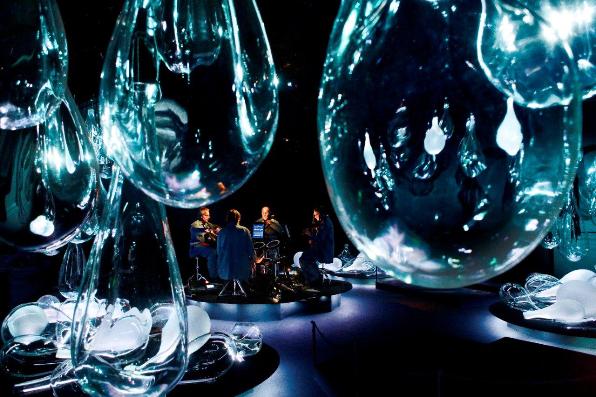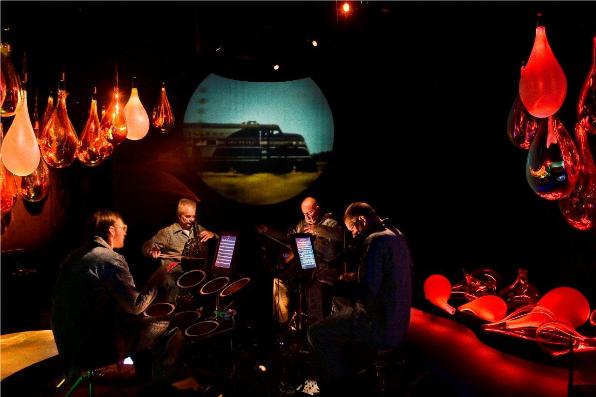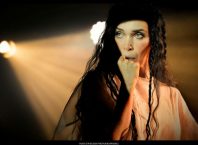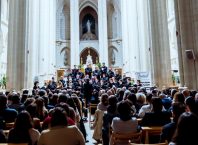I’ll never forget the first time I heard Steve Reich’s Come Out (1966). Experiencing voice as sound, the rhythms of repetition creating a form between poetry and music, word as text and element within the composition, the desperation of the young man whose words were recorded, opening up a wound to let the blood come out so that he might receive medical attention; urgent and beautiful, the sound still echoes in my mind to this day.
Come Out and It’s Gonna Rain (1965) are early works of Reich’s which explore the use of recorded speech transferred to multiple tape loops and Reich’s innovative compositional technique of phasing: playing the same sequence on two instruments (live or recorded) in a constant and close, yet not identical tempo, creating a pattern of sound between the two that begins in unison, diverges, creates an echo, moving further apart until the sound diverges from the word creating its own patterns, and returns to unison. Come Out was composed as a benefit for the retrial of six African-American teenagers accused of murder and beaten by the police, using the voice of Daniel Hamm, who was ultimately acquitted.

Different Trains (1988) for string quartet and tape, represents a return to recorded speech, yet in this composition Reich uses speech as a source for creating melody, turning to his personal history and relationship to Jewish history for inspiration. Reich, whose parents divorced when he was quite young, travelled across the US by train with his governess throughout his childhood. As an adult reflecting on this experience, which he recalled fondly, he noted that, “if I had been in Europe during this period as a Jew I would have had to ride very different trains.”
The Jewish Theatre of Sweden’s production of Steve Reich’s Different Trains comes to the Tower of David Museum’s kishle, as part of the Jerusalem Season of Culture for a three week run from June 30, 2011 to July 21, 2011. The kishle, which served as a prison during Ottoman times, has been transformed into a performance hall for this unique visual concert. . Excavations conducted during this process uncovered archaeological findings which will be shown for the first time, including two walls of King Herod’s palace and an ancient drainage system that transported sewage from the palace to outside the city walls, parts of the Hasmonean city wall (2nd C. BCE) and a wall from the time of King Hezekiah (8th C. BCE).
Pia Forsgren, Jewish Theatre Manager and Artistic Director, presents an interpretation of Reich’s work, performed by the Fleshquartet amidst a glass installation by Ann Wahlstrom with lighting design by Hans-Ake Sjöquist and costumes by Mikael T. Zielinski. Different Trains comprises the first part of the program, with Tears Apart, a composition by the Fleshquartet created in relationship to Different Trains, in the second part.
Reich explains the process of creating the work on the Jewish Theatre site. He made recordings of his governess Virginia, a retired Pullman porter, Lawrence Davis and Holocaust survivors Rachella, Paul and Rachel discussing their memories and experiences, annotating the speech samples to create a musical score for string quartet, which became a part of the composition, as a live performance alongside the recorded elements. The performance at the Tower of David in the kishle will be all electronic instruments, with Reich’s approval.

The performance promises to be a unique experience in every way. An intimate audience (capacity is 120 per performance) will sit among the musicians and glass installation, with large, drop shaped glass forms hanging from the tall ceiling and placed on the central podium where the musicians perform. Pia Forsgren, who arrived in Jerusalem with Ann Wahlstrom and the production team to set the performance on the new venue, said, “It is very important for us that the audience come very close to the creation – the music. You can physically feel the musicians playing.”
Creating the glass works was an adventure for Wahlstrom who said that it was the first time she had an opportunity to design glass to fill an entire room. Finding a place that could accommodate the structures she had in mind was not an easy task, as the glassworks industry in Sweden has practically disappeared. Wahlstrom worked with a Czech factory that usually made glass for the chemistry industry. Accustomed to precise measurements and manufacturing identical pieces, the glassmakers there had never before worked with glass in this way. The audience arriving for performances at the kishle will walk through the dry moat surrounding the Tower of David Museum; a video of the glassmaking process will be screened on the stone wall mid-way to the kishle.
Reflecting on the history of Reich’s Different Trains, Forsgren said that she wanted to stage the work to, “Create a space for mourning. The most beautiful thing you can experience in life is to survive.”
Performances will take place on Saturdays and Monday – Thursday at 20:00 and 22:00, from June 30, 2011 to July 21, 2011. To reserve tickets call: Tower of David Museum *2884, or Bimot *6226.






This is very interesting! Great information and it is also very well written. I will bookmark and comeback soon.
Comments are closed.